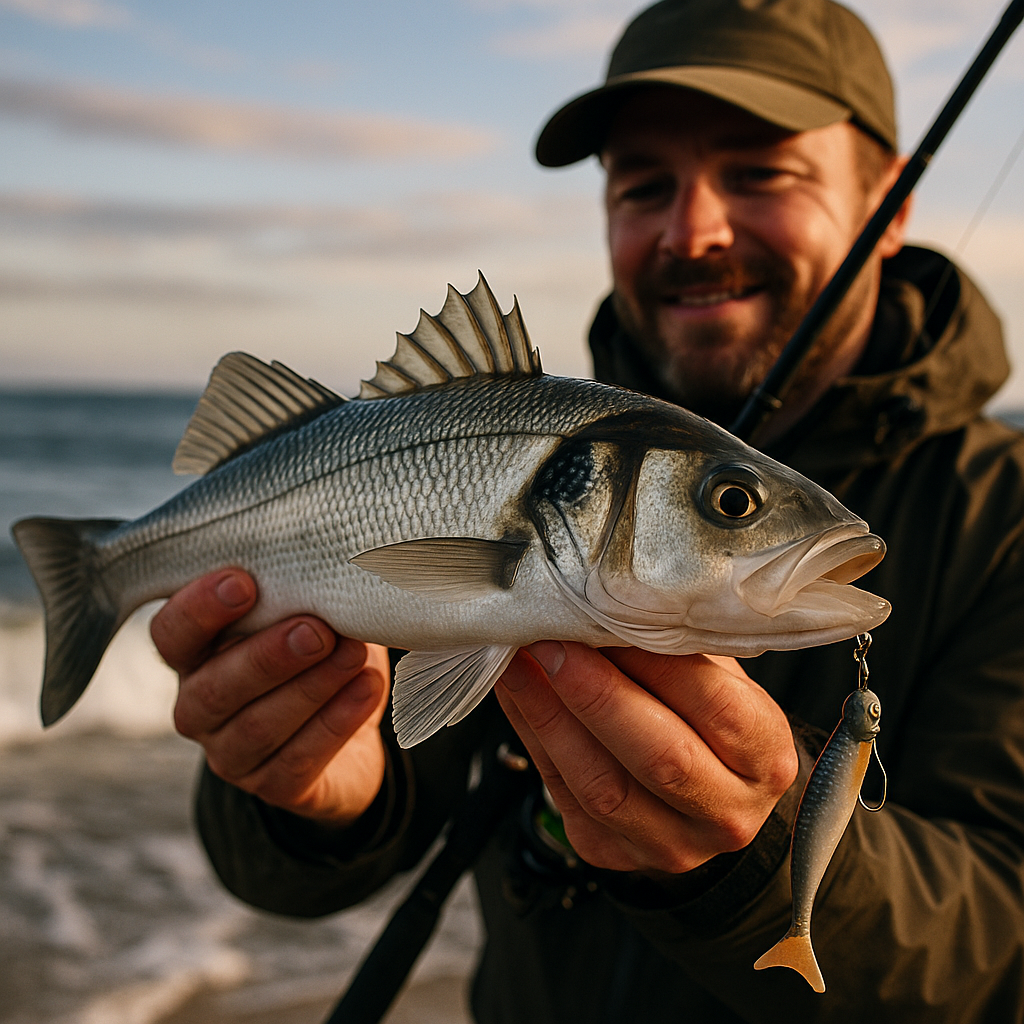1. Introduction
The moment I caught my first sea bass
I still remember that strike on a surf beach in Waterford — my 9-foot rod tip dipped sharply, the drag screamed, and my heart jumped. A silver torpedo burst from the waves, and from that moment, I was the one who got hooked — for life.
Why you can trust me
Since then, I’ve spent hundreds of sessions guiding others across the rocks of Britain and Ireland, testing dozens of reels, lines, and lures. What follows is a distilled guide — drawn from real bites, lost fish, and gear that’s survived salt, sand, and rock tumbles.
What you'll learn
-
A clear gear checklist: rods, reels, lines, leaders
-
How tides, moon phases, and weather create golden windows
-
Step-by-step techniques for lure and bait presentation
-
Rock and surf safety essentials
-
My personal picks — including the Golden Catch Rod Passion Power I'm using this season
2. Why It Matters – Common Mistakes
Three frequent mistakes anglers make
-
Oversized lures — impressive in the packaging, but unnatural compared to local baitfish
-
Ignoring the tide — fishing slack water where the fish are dormant
-
Using surf “broomsticks” that can’t absorb bass surges or hold the hook securely
Bass behaviour and seasonal activity
In UK and Irish waters, bass move inshore when temps rise above 10 °C — typically from late spring. Peak action hits in summer and early autumn. The driving factor is tide movement: fish are most active on the flood, especially at dawn and dusk.
| Month | Temp | Typical Spot | Activity |
|---|---|---|---|
| April | 9–11 °C | Estuary mouths | Scouting |
| June | 12–15 °C | Surf beaches | Aggressive hunting |
| August | 16–18 °C | Rocky points | Big lone specimens |
| October | 12–14 °C | Deep gullies | Final feeding run |
The hidden cost of cheap gear
Trust me — I’ve lost fish to clunky rods, dead reels, and leaders shredded on oyster beds. Cheap ends up expensive. Quality sea fishing rods save your nerves (and wallet) over time.
3. Key Factors for Success
Reading terrain and structure
Bass patrol the edges: white water meeting rocks, estuary drop-offs, kelp lines. If there's cover, current, and an escape route — you’re likely in the right place.
Tides, moon phases, and weather windows
On neap tides, I lean toward bait. On big, moody tides, it's lure time — two hours after low water is when things come alive. I favour low pressure, a light southern breeze, and overcast dawns.
Tackle checklist
-
Rod: 9–10 ft, 20–30 g casting weight
-
Reel: 3000–4000 size
-
Mainline: PE 0.8–1.0 (≈ 20 lb)
-
Leader: 20 lb fluorocarbon, 60–80 cm, FG or Albright knot — knot tutorials on our YouTube
-
Terminal gear: 30 lb swivels/clips, sharp singles or trebles
Find balanced models in our Spinning Rods collection.
4. Techniques and Tools
Casting angles and distance control
-
Side casts parallel to the surf line keep your lure in the foam
-
Overhead casts let you clear the break — feather the spool to lay the line neatly
-
Power should be smooth, pendulum-like — yanking costs distance
Lure presentation secrets
-
Walk-the-dog – topwater zig-zag, great in calm dawns
-
Slow-roll – steady retrieve with paddle tails in murky or cold water
-
Stop-and-go – a few turns, then pause — that pause triggers strikes
Match lure colours to water clarity: silver for clear water, chartreuse in the murk. More details in our article: [How to choose lures for sea bass fishing]
5. Safety and Best Practices
Tides and waves
Always plan your exit — I mark a “cut-off point” an hour before peak tide. If swells hit the rocks, I climb higher or call it a day.
Weather-ready gear
-
Breathable jacket with cuffs
-
Studded boots
-
Auto-inflate life vest
-
300-lumen headlamp, IPX8 water rating
6. My Picks and Gear You Can Trust
Current rod – Golden Catch Rod Passion Power
9’6”, rated 12–42 g: casts a 28 g shad almost 80 m, yet the soft tip cushions a feisty 2 lb schoolie. Matched with a 4000 reel and 0.13 mm 8-strand braid.
Top Sea Fishing Rods Collection
1
2
3
Reels and lines I trust
1
2
3
20 lb 8-strand braid + 1 metre of 0.37 mm fluoro – FG knot flies through guides with zero clicking.
7. FAQs
What’s the best lure weight for bass?
Most of my catches come on 12–28 g lures, around 12 cm long — a close match to local baitfish.
Do I need a fluorocarbon leader?
Absolutely. 20 lb fluoro resists shell abrasion and is near-invisible in clear water. Keep it shorter than your rod to avoid the knot hitting your tip ring.
Can I fish from piers?
Of course. Cast along the wall, look for gullies near ladders, and be mindful of crab lines and slippery tiles.
8. Final Thoughts & What’s Next
Quick summary
-
Fish moving water at dawn, dusk, or on the flood tide
-
Use 9–10 ft lure rods, 20 lb braid, and abrasion-resistant leaders
-
Try different retrieves until bass “tell” you what works
-
Safety always comes first
Want to go deeper on lure colour and action? Read: [How to choose lures for sea bass fishing]
Get geared up and go!
The season’s open — check out our Sea Fishing Rods and Spinning Rods, pick a setup that suits your budget, and I’ll see you on the shore with your next personal best.
Tight lines! 🎣

